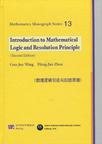数理逻辑引论与归结原理
出版时间:2009-1 出版社:科学出版社 作者:本社 编 页数:335
前言
Modern mathematics has acquired a significant growth level with the rapid progress of science and technology.Conversely we can also say that the development of modern mathematics serves to lay the foundations for the progress of science and technology.Mathematics till date has not only been a towering big tree having the luxuriant growth of leaves and branches but has also deeply rooted itself in the areas of morden science and technology.According to the Mathematics Subject Classification 2000 provided by the American Mathematical Society,the subjects have been numbered from 00,01……,up to 97 except absence of a minority and each class has been further classified into tens of sorts of research directions.It iS thus clear that the contents of mathematics are vast as the open sea and mathematicians having a good command of each branch like in the times of Euler no longer exist. As stated above,modern mathematics has numerous branches,the research contents and methods of distinct branches are very different. Hence it is not re- alistic to expect mathematical researchers to be proficient in all branches.But it is,in our view,necessary for them to acquaint themselves to a certain extent with the contents and methods of mathematical logic.By‘acquaint themselves to a certain extent withwe primarily mean that they should understand the introduc-tion to mathematical logic,i.e.the theory of logical calculi,including propositional and first order predicate calculi,because it is not only the common foundation of axiomatic set theory,model theory,proof theory and recursion theory in mathe- matical logic,but also the part in which non-logical experts are most interested. Particularly for scholars who are engaged in teaching and scientific research in spe- cialized subjects of computer,applied mathematics,artificial intelligence and SO on and for university students and graduate students who are studying in these specialities,a familiarity with logical calculi is necessary.
内容概要
本书在第一版的基础上进行修订再版,全书共9章,内容可分为Boole代数理论,命题演算与谓词演算理论,归结原理理论,多值逻辑的最新理论等4部分。同时,在第一版的基础上对“计量逻辑学”,关于一阶系统K完备性的证明等诸多内容做了补充或改写。 本书可供计算机专业、应用数学专业、人工智能专业的研究生与高年级本科生及教师阅读。
书籍目录
PrefaceChapter 1 Preliminaries 1.1 Partially ordered sets 1.2 Lattices 1.3 Boolean algebrasChapter 2 Propositional Calculus 2.1 Propositions and their symbolization 2.2 Semantics of propositional calculus 2.3 Syntax of propositional calculusChapter 3 Semantics of First Order Predicate Calculus 3.1 First order languages 3.2 Interpretations and logically valid formulas 3.3 Logical equivalencesChapter 4 Syntax of First Order Predicate Calculus 4.1 The formal system KL 4.2 Provable equivalence relations 4.3 Prenex normal forms 4.4 Completeness of the first order system KL*4.5 Quantifier-free formulasChapter 5 Skolem's Standard Forms and Herbrand's Theorems 5.1 Introduction 5.2 Skolem standard forms 5.3 Clauses*5.4 Regular function systems and regular universes 5.5 Herbrand universes and Herbrand's theorems 5.6 The Davis-Putnam methodChapter 6 Resolution Principle 6.1 Resolution in propositional calculus 6.2 Substitutions and unifications 6.3 Resolution Principle in predicate calculus 6.4 Completeness theorem of Resolution Principle 6.5 A simple method for searching clause sets SChapter 7 Refinements of Resolution 7.1 Introduction 7.2 Semantic resolution 7.3 Lock resolution 7.4 Linear resolutionChapter 8 Many-Valued Logic Calculi 8.1 Introduction 8.2 Regular implication operators 8.3 MV-algebras 8.4 Lukasiewicz propositional calculus 8.5 R0-algebras 8.6 The propositional deductive system L*Chapter 9 Quantitative Logic 9.1 Quantitative logic theory in two-valued propositional logic system L 9.2 Quantitative logic theory in L ukasiewicz many-valued propositional logic systems Ln and Luk 9.3 Quantitative logic theory in many-valued R0-propositional logic systems L*n and L* 9.4 Structural characterizations of maximally consistent theories 9.5 Remarks on Godel and Product logic systemsBibliographyIndent
图书封面
评论、评分、阅读与下载
